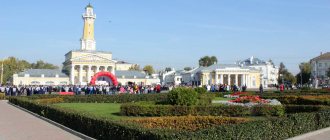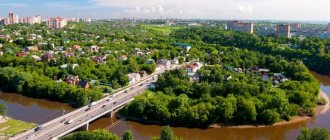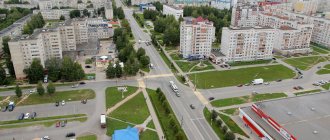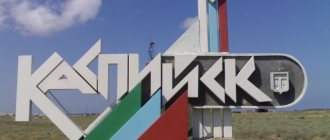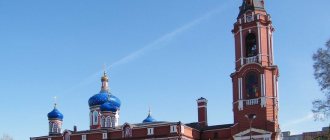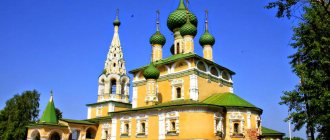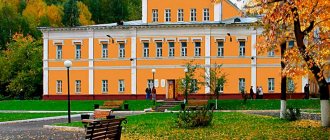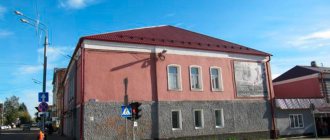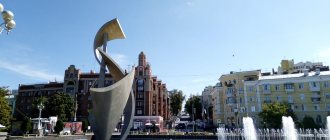Countries > Russia
Kostroma is one of the most unusual points of the Golden Ring. Each historical era has greatly changed its appearance, so now it is a city of contrasts with ancient monasteries, merchant mansions and Soviet buildings. In addition, there are many interesting museums and architectural monuments in the center and surrounding areas. What is worth visiting during your visit is in this post.
- Sights of Kostroma
- Neighborhood
- Museums
- Map
In the center
Shopping arcades
The shopping arcades are reminiscent of the former heyday of Kostroma as a center of merchants and trade in the 18th century. Walking under the arched vaults with dozens of benches, it is easy to imagine what the rows - or Gostiny Dvor - looked like at that time, because their appearance has remained virtually unchanged. Now Kostroma souvenirs, products of local farmers and artisans are sold here. There is a market inside during the daytime.
The complex is also interesting from an architectural point of view. The project considered the area of each merchant store and the arched entrance to them. A similar design of rows has been preserved in Uglich.
st. Red Rows, 1
Working hours: 10:00-19:00
Free admission
Church of the Savior in Rows
The dominant feature of Gostiny Dvor is the five-domed church of the 18th century in the pre-Petrine style. The temple fits harmoniously into the architectural ensemble of rows and complements the composition. During Soviet times, an anti-religious museum was located inside, and part of the bell tower was dismantled. Then the premises were used as a warehouse for a long time, and only in the 1990s was it returned to the Russian Orthodox Church and restored to its original appearance.
st. Red Rows, 1
Susaninskaya Square
All main streets diverge from the central square - Susaninskaya, named after Ivan Susanin, who was a Kostroma resident. There is a monument in his honor in the square.
The streets radiating from the square resemble a fan, and this layout makes it easy to navigate the center. On the main streets you will find many architectural monuments from different historical eras. At the same time, the square itself is rich in historical buildings.
Fire Tower
It is impossible not to notice the tallest building and symbol of Kostroma - the Fire Tower. Once upon a time, it delighted Nicholas I, who even regretted that there was no such tower in St. Petersburg. Until the beginning of the 21st century, it was used for its intended purpose, and now it is a museum-reserve with a historical exhibition. Similar projects can be found in other cities, for example, in Uglich.
Borschov's House
Also attracting attention is a large classical building - the Borschov House. It is difficult to imagine that such a monumental building was originally built as a residential estate. The emphasis is on the facade with an eight-column portico, which fits into the composition of Susaninskaya Square. In the 19th century, when Russian emperors and writers came to the city, they stayed there, including Zhukovsky.
Wiki/Commons
Guardhouse
The architectural ensemble of the Guardhouse Square is also completed in the style of late classicism. Previously, a guard was located here and until the beginning of the 20th century the building served its original purpose. Now it is occupied by a branch of the Kostroma Museum.
Central Park
The Kostroma Kremlin, which was once the architectural dominant of the historical center, has not survived to this day. Several churches burned down in a fire in the 18th century, and the rest were destroyed in 1934 as part of an anti-religious campaign. Now in its place is a park with a monument to Lenin and an observation deck.
Lenin monument
For the centenary of the House of Romanov, it was planned to erect a monument in his honor on the territory of the Kremlin. However, the revolution of 1917 happened, after which, of course, there could be no talk of any monument to the royal family. They decided to use the pedestal, which was already ready, for another purpose and erect a monument to Lenin on it. The discrepancy in proportions is noticeable even now - the pedestal and the monument obviously do not suit each other.
Now, from the other side, the panorama without the Kremlin seems incomplete, especially when comparing the current view with historical photographs. Work is currently underway to restore some churches of the former Kremlin, so part of the historical appearance will be recreated.
There is an observation deck in the park, which offers a beautiful view of the Volga and the embankment.
Working hours: 10:00-21:00
Free admission
Soviet street
Sovetskaya Street is the main street in the city; it runs through all the main areas from the bus station and railway station to Susaninskaya Square. Since the street crosses the entire Kostroma, it contains the most striking contrasts in the development. It preserves wooden residential houses, merchant mansions in the Art Nouveau style, ancient churches, and Soviet minimalist buildings.
Closer to the square there are good examples of Art Nouveau with characteristic expressive decor.
Also, most cafes and shops are concentrated on Sovetskaya Street.
Simanovsky Street
Another ray extending from Susaninskaya Square is Simanovsky Street. Perhaps this is one of the few places in Kostroma where the atmosphere of the ancient city has been preserved. There are no modern buildings on it, so it’s easy to imagine what it looked like several centuries ago.
Among the surviving monuments: Stozharov's house, Tretyakov's houses and other merchant mansions.
Kostroma Hotels
Hotels and sanatoriums in Kostroma are located both within the city and in its immediate surroundings. Tourists can choose from expensive high-level hotels, hotels of a “socialist” model, affordable hostels, as well as country hotels and guesthouses that will be convenient for those traveling by car. The city itself is small, so there is no need to look for hotels near attractions - even from the farthest hotel to the center it takes no more than half an hour. However, most hotels in Kostroma are still located in the Central region.
Among the best hotels in Kostroma are the “four” “Aristocrat” and “Golden Ring”. More affordable in price, but with a full set, the recently reconstructed Volga and Azimuth. An excellent option for a fabulous vacation with children is the Snegurochka Hotel, which is actually combined with a tower. You can enjoy the Volga views and feel like literary heroes at the Ostrovsky Pier.
Among the sanatoriums of Kostroma and the region, the most famous is the sanatorium named after. Ivan Susanin, located in a pine forest 18 km from the city, the sanatorium named after. Borodin, built right on a mineral spring, and the Yubileiny sanatorium in ancient Nerekhta.
Wooden architecture
To see the amazing carved decor and platbands of wooden houses, be sure to take a walk along Shagova, Sennaya and Engels streets. Over time, architectural monuments and wooden decor are becoming more unique and rare, so wherever this heritage has been preserved, you should try to visit such neighborhoods.
In addition to wooden houses, Kostroma has many red brick buildings from the early 20th century. The outskirts are built up with Soviet panel houses and new high-rise buildings.
Church of the Resurrection of Christ on Debra
One of the most beautiful churches in Kostroma was built in 1651 on the banks of the Nizhnyaya Debra River. There is a legend associated with its construction. It was as if a wealthy merchant, expecting goods from England, found gold bars in barrels instead of the paint he was supposed to receive. The English partners never found the owner of the treasure and advised the merchant to invest the wealth in a good cause. So he did, adding his own funds and organizing a fundraiser. Unfortunately, the merchant did not live to see the completion of construction, but the result of his efforts is still admired today.
The five-domed church building is decorated with numerous details: unusual decorative elements, paintings and stone carvings depicting mythical creatures. During its rich history, the temple has undergone some changes, for example, in the 18th century, a one-story gallery with arches was built around it, and in the 19th century, a sacristy was added and the frescoes were painted in a new way. Travelers will get acquainted with local shrines: the ancient iconostasis, particles of the relics of the Kiev-Pechersk saints and the miraculous icon of St. Nicholas of Myra.
Neighborhood
Holy Trinity Ipatiev Monastery
Not far from the center there is an ancient monastery, very important from a historical point of view. Firstly, once upon a time it was within its walls that the Ipatiev Chronicle was found - one of the oldest documents and sources of information about ancient Rus'.
Secondly, the Ipatiev Monastery was captured by False Dmitry II and even turned into a real armed fortress.
Thirdly, it was here that the Time of Troubles was put to an end, through a ritual for the reign of Mikhail Romanov. Due to this, it is considered an important place in the history of the Romanov dynasty. Museum exhibitions located in the monastery premises will tell you more about the history.
Photo from Wikipedia.
st. Prosveshcheniya, 1
Time: 09:00-17:30
Entrance: 150 rub.
Kostroma Sloboda
Near the monastery there is another interesting point - the Ethnographic Village, which recreates peasant life and stores important household items of that time. The museum-reserve also stores important architectural monuments transported here from territories flooded during the creation of the Gorky Reservoir.
Znamensky Monastery
While other Kostroma monasteries are popular among tourists, the Znamensky Monastery rarely makes it onto tourist routes. That is why it is worth coming here for the real atmosphere of monastic life, peace and quiet. It is surprising that the monastery was founded relatively recently and unites two ancient churches - the Resurrection of Christ and Znamenskaya.
The Church of the Resurrection of Christ on Debra deserves special attention. The five-domed composition is surrounded by galleries with hipped porches, and next to it is the Holy Gate with two expressive arches and rich decoration. Previously, the facade was decorated with bright paintings and decorative details, but, unfortunately, all of them have not been preserved.
Wiki/Commons
st. Nizhnyaya Debra, 37
Time: 08:00-17:00
Free admission
Elk farm
The Sumarokovskaya farm is a rare place with domesticated moose, which you can feed and take pictures with. You will have to get to the farm yourself by car or with a tour.
village Sumarokovo
Time: 10:00-15:00
Entrance: 100-150 rub.
Nearby cities
In the neighborhood of Kostroma there are many interesting places where you can go for one day: Yaroslavl, Ivanovo, Bui. In addition, the region has many ancient towns with a rich history, for example, Nerekhta and Krasnoe-on-Volge.
Excursions
When planning a trip to Kostroma, you need to remember not only about the museums, but also about such a unique place as the Elk Farm. There are regular excursions to the Sumarokovsky reserve, the schedule of which can be found on the farm’s website. It is also necessary to take into account the time of visit, for example, in the warm season, animals are transferred to a summer camp, with the onset of cold weather - to a winter camp. When going for a walk, it is better to prepare immediately, since the farm is located in the forest, you will have to walk a lot. But it’s worth it - where else can you not only see moose up close, but also feed them (carrots are included in the price of entrance tickets, the price is 150 rubles). In the summer you can also buy moose milk.
Part of the day can be completely devoted to excursions to the Ipatiev Monastery . This is a large architectural and historical complex, which in the 14-15 centuries was a real outpost of the north-eastern part of the Russian State. The first mention of this monastery dates back to 1432; today it is an active institution. The New Town is closed to visitors, but there is access to the Old Town (admission is paid).
To visit, you must first book a pilgrimage excursion or take advantage of individual programs with guides. It is recommended not just to take a walk around the territory, but also to visit all available locations and museums - this will be an unforgettable excursion. Near the main entrance there is a souvenir shop where you can buy souvenirs.
Museums
Historical
The exhibition is located on the first floor of the Fire Tower on Susaninskaya Square. The museum will introduce you to the history of the city and region.
Wooden architecture
It is located not far from the Ipatiev Monastery and consists of unique centuries-old wooden buildings. In addition to the exterior wooden decor, the buildings and churches have restored historical interiors and furniture.
Wiki/Commons
st. Prosveshcheniya, 1B
Time: 09:00-17:00
Entrance: 100-150 rub.
Flax and birch bark
The exhibition will tell about the ancient origins of the use of flax and birch bark, the cultural traditions of the region and the country as a whole associated with these materials.
st. Tereshkova, 38
Time: 09:30-17:00
Entrance: 50-100 rub.
Nature of the Kostroma region
The museum's dioramas will show the diversity of nature and animals. Reconstruction of scenes from the animal world and a petting zoo will be of interest to both adults and children.
st. Milk Mountain, 3
Time: 10:00-18:00
Entrance: 80-120 rub.
Holy Trinity Ipatiev Monastery
The monastery is considered one of the oldest in Russia, it was founded at the beginning of the 14th century and is located in a picturesque place - the “arrow”, where the Kostroma River flows into the Volga. Many historical events are associated with this place, significant not only for the Kostroma region, but also for the history of Russia as a whole. Here, in the 17th century, the end of the Great Troubles began, and in 1613, on the territory of the monastery, Mikhail Romanov, the founder of the dynasty of rulers, was elected to the kingdom (that is why the monastery is called the “cradle” of the House of Romanov).
Travelers will see here more than ten historical buildings such as the chambers of the Romanov boyars, the Catherine Gate, residential cells, get acquainted with the main temple of the monastery - the Trinity Cathedral of the 17th century, and “touch” the main shrines: the Tikhvin Icon of the Mother of God, a piece of the Robe of the Lord, pieces of the coffins of St. Nicholas the Wonderworker and Matrona of Moscow and a particle of the relics of the holy martyr Hypatius. In addition, you can visit the museum located on the territory of the monastery; various religious antiquities are exhibited here, and part of the exhibition is dedicated to the Romanov dynasty.
Where to stay
Kostroma has quite a large selection of accommodation, including budget hostels, good hotels, and private apartments. It is better to choose housing in the center, since the difference in price will be small and you will not have to waste time on the road.
It’s easier to choose the right option in the Hotellook aggregator, since the prices of all popular search engines, including Booking, are immediately presented there.
Private housing, including apartments and houses in the region, is more convenient on Sutochno.ru in Kostroma
How to get to Kostroma
Train and bus are the most popular modes of transport by which you can arrive in Kostroma. They travel from Moscow and St. Petersburg, as well as cities in the northern and central regions of Russia. In addition, from St. Petersburg to Kostroma
you can travel by plane. Kostroma is connected with both capitals in some places by excellent, in others by simply good roads with the inevitable picturesque views included. Read more about how to come to Kostroma on the page “How to get to Kostroma”.
- How to get from Yaroslavl to Kostroma
Search for cheap flights to Kostroma
Stele "400 years of the House of Romanov". Monument to Ivan Susanin
Peasant Ivan Osipovich Susanin accomplished a well-known feat. In the winter of 1613, he tricked Polish soldiers into impenetrable forest swamps. Thus, he saved Tsar Mikhail Romanov from attack. In the park named after Mikhail Fedorovich Romanov, at the top of Milk Mountain, there is a monument to Ivan Susanin. The monument by sculptor N. A. Lavinsky was erected in 1967.
The Snow Maiden's Tower
Another “fairy-tale” place that will not leave either children or adults indifferent. Kostroma is considered the birthplace of the Snow Maiden, the granddaughter of Father Frost, and here Nikolai Ostrovsky created a fairy tale about her. A tall log tower, decorated with carved lace, is part of the entertainment complex. Here the Snow Maiden meets her guests with a loaf of bread and introduces her assistants - the cat Bayun and the brownies.
Then travelers will explore the fairy-tale heroine’s room and watch a puppet show. After this, Snegurochka arranges a teleconference with Father Frost for her guests. And after seeing the room of miracles and the Christmas tree room, you can visit the ice room. Its walls are lined with real ice, all the furniture and utensils are also made of ice, so that it all does not melt, a fairly cold temperature is maintained (-15 degrees), so before visiting the room, guests are given warm clothes and shoes, in addition, everyone receives a treat from ice cups.
In addition to the tower itself, there are many “fairytale” buildings on the territory of the complex. There is a belfry, stylized souvenir shops, a restaurant serving Russian cuisine and playgrounds. Signpost stones, like in fairy tales about heroes, will help you not get lost. In addition to the excursion program, there is also a play program: you can play with the brownies, run around and dance in circles.
death camp
Industrial tourism has also become popular in Kostroma. Stalkers, as these travelers call themselves, are engaged in the exploration of abandoned structures. For a long time, the center of attraction for them was the gigantic Galich TV tower - the tallest abandoned building in Russia. Its construction was frozen back in the 1990s, and since then crowds of extreme sports enthusiasts, skydivers and rope jumpers have come here. In the summer of 2021, due to the danger of collapse, the tower was dismantled.
Twice on the same river: from Moscow to Kineshma and back
How does a river cruise on the Volga work?
There is another notorious place in the Kostroma region - the Unzhlag logging site. Hundreds of thousands of convicts passed through it, and the number of deaths has not yet been calculated. Unjlag united about 30 Gulag camps. Its ruins are scattered throughout the Kostroma and Nizhny Novgorod regions. You can get to these places by SUV, but you still have to walk part of the way. There are very few traces of the existence of the camps, but people still go to the Makaryevsky district, where they examine rickety fences, wooden barracks and the ruins of punishment cells.
Cheese region
The main delicacy of Kostroma is cheese. “Kostromskoy”, which appeared at the end of the 19th century at the cheese factory of Vladimir Blandov, was one of the three most popular varieties in the USSR. If the recipe is intact, it should taste like Dutch Gouda. The cheese has a pale yellow color, a delicate creamy smell and a slightly sour taste.
The easiest way to learn more about the local delicacy is at the Cheese Museum, which opened in Kostroma a year and a half ago. To make it easier for tourists to find it, a life-size statue of a cow was installed in front of the building. The museum has five halls, in each of which guides, called sommeliers, talk about one of the milestones in the history of cheese making. Museum exhibits can not only be seen, but also tasted and bought. Classic Kostroma cheese is also sold at the Cheese Exchange, which is easy to find inside the Kostroma shopping arcades on the main square of the city.
Kostroma
Cheese "Golden Ring"
Photo: RIA Novosti/Alexey Kudenko
